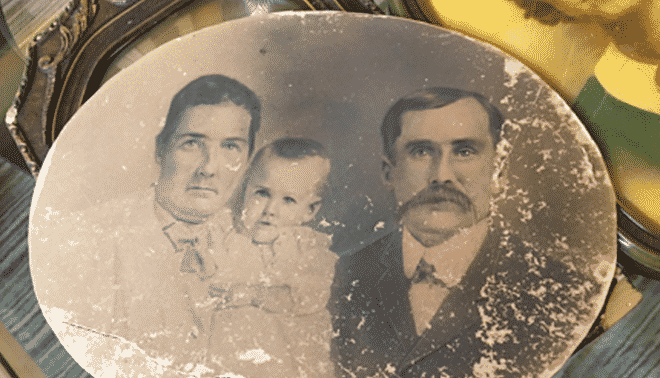Sign up for the Family Tree Newsletter! Plus, you’ll receive our 10 Essential Genealogy Research Forms PDF as a special thank you.
Get Your Free Genealogy Forms
"*" indicates required fields
Last week’s Photo Detective introduced this image submitted by Holly Burford. We covered some methods for mitigating the environmental dangers to your family photos. It’s a lovely picture of a young family—mom, baby, and dad. Holly Burford’s father is hoping that there are enough clues in this photo to determine the identity of the people depicted. The Burfords have enough information to compare photo clues to census records and other genealogical data.

1. Trace the Chain of Ownership
There are clues like clothing in every picture, but there is also genealogical evidence. The place where those two items intersect is where photo identification occurs.
First, Holly mentioned that her grandparents gave this picture to her father’s brother. This is good news because it establishes a clear history of ownership. That helps us stick with the correct side of the family. Additionally, it’s probably an early twentieth-century picture. This means there are only a few generations between when this image was made and it was given to Holly’s uncle.
That’s the good news. The bad news is that no one can recall who they are. There are also no clues that indicate which side of her father’s family is represented.
All is not lost. As genealogists, we start with the present and work backward. It’s a good idea to do that with pictures too. In this case, we’ll start with Holly’s paternal grandparents. They were born in 1904 and 1910. Her grandfather’s mother was a Moore and his father was a Walker. On her grandmother’s side, they were Pittmans and Thompsons. If there are family photos of those ancestors, they will be useful for comparison. Who do the parents resemble? Holly and her dad should check with other relatives to see if they have any family photo albums or collections to compare it with.
2. Use Cultural Clues to Establish a Time Frame
Heavy mustaches were the fashion in the late 1880s to late 1890s, but by the early twentieth century, most men were clean-shaven. On the other hand, the puffy sleeves on the baby’s dress suggest a date in the late 1890s to early 1900s. The overlap in the dates suggests a time frame in the late 1890s to turn of the century.
It’s important to consider the identity of the baby. Who was born in that time frame? Keep in mind that the baby could be a boy OR a girl. In a case like this, find out all you can about the families related to the grandparents, specifically:
- Who was of child-rearing age?
- Is this the portrait of the only baby this couple had?
- Is it a portrait of them with their oldest child?
3. Compare Photo Clues to Available Records
Now it’s time to compare the photo to census records, starting with the 1900 census. Make a list of all the adults who could be the parents of the child and compare them to census data. Holly is looking for a couple that may have a single baby or one with no children. This is the type of portrait often taken of parents and their first child.
Next, look at the 1910 census. Which family members are the right age to be in this picture? If the baby was born around 1898 then they’d be 12 in the 1910 census. If the baby were born in the early twentieth century, like Holly’s grandfather, then they’d be around 6 years of age.
This could be an image of Holly’s grandfather, born 1904. It’s possible the father liked his mustache and didn’t shave it off to suit fashion. If that’s the case, does the family have images of the great-grandparents? These would be useful for comparison.
This seems like a solvable problem. Charting the family in two censuses and using other family photos for comparison should provide a solid foundation for identifying this family.
FamilyTreeMagazine.com is a participant in the Amazon Services LLC Associates Program, an affiliate advertising program designed to provide a means for sites to earn advertising fees by advertising and linking to Amazon.com and affiliated websites.









